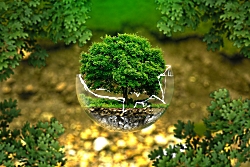
Image by ejaugsburg from Pixabay
One of the pleasures of hiking in scenic vistas, such as our forests or National Parks, is to see the wildlife that call those places home. People want to see bears or wolves in Yellowstone. They are thrilled when they see Desert Bighorn Sheep in Arches or Zion. But the latest comprehensive report on biodiversity by the United Nations revealed some startling results. The report included over 1,000 pages compiled by more than 450 researchers who analyzed 15,000 scientific and government reports. And this summary had to be approved by representatives of all 109 nations.
The message is that nature is being threatened more now than any other time in human history. Literally, a million species of plants and animals are facing serious threats to their survival. And this is due to several harmful actions: Invasive species that crowd out native wildlife from their home habitats; the pollution of water and land by the dumping or runoff of toxic materials; overfishing the oceans; and permitting the continual burning of fossil fuels which alter the climate for some wild species. And, as a result of increasing human populations, many forests and grasslands are converted into farmland, cities, or business ventures. That reduction in the number of large plants and trees affects the Earth’s ability to reduce heat-trapping carbon dioxide.
Currently, over 1,200 mammal species, 1,500 bird species, and 2,300 fish species are threatened, endangered or extinct in the wild.
This indeed sounds dismal, but if we consider it as a warning there is still time left to alter this downward spiral. What can we do? Simple tasks, really: Replace lawns by planting trees, shrubs and flowers native to your area. This provides habitat as well as food for pollinators. Avoid using harmful pesticides and herbicides which can collect and wash down into streams and rivers, which then pollute that water as well as the ocean. Respect the privacy needed by wildlife by observing them from a distance. Never poach any species. Place birdfeeders and/or birdhouses in your area. Consider renewable energy sources for your home and community. Don’t allow your vehicle engines to idle. And encourage your community to preserve open, green spaces when new developments are proposed.
Life is easier if we decide to let others do the work that will benefit us all. But if everyone made some small improvements in their lifestyle we might be able to avoid future dismal reports.
This is Ron Hellstern, and I am Wild About Utah.
Extinction or Survival-Credits:
Images: Courtesy & Copyright
Lead Audio: Courtesy and Copyright Kevin Colver
Text: Ron Hellstern, Cache Valley Wildlife Association
Extinction or Survival-Additional Reading
